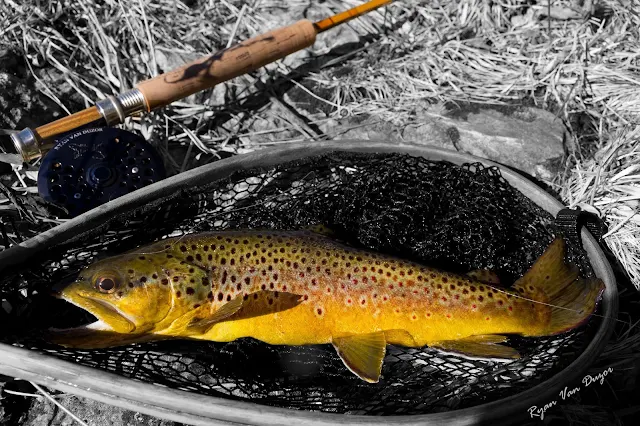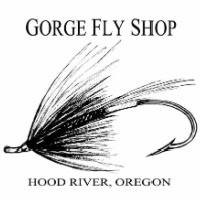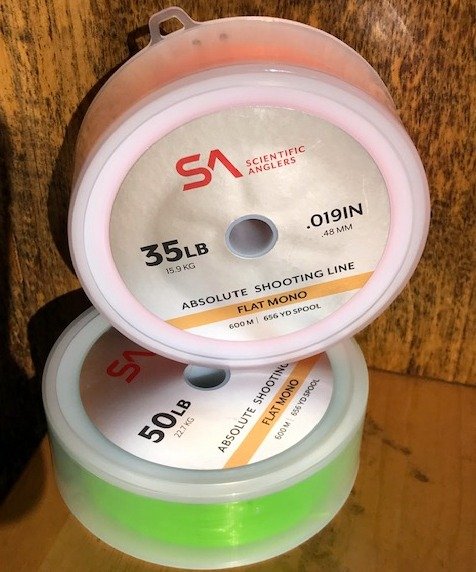 |
| John fighting a Chrome winter Steelhead while the snow falls |
We get asked a lot what gear we are personally using here in the shop. Well, it is winter steelhead season here, our favorite time of year to fish, and all of us at the shop are polishing up our rods and reels, collecting lines and sink tips, and tying flies like madmen. John, Ryan and I fish as much as anyone else out there and this is the gear that we are rocking for the winter.
John:
G. Loomis NRX 13’ 7/8
Galvan Torque T-10
 |
| G. Loomis NRX |
The G. Loomis NRX 13’0” 7/8wt is one of the sweetest rods out there. It is light in hand, and the grain window is huge, but it fishes best with lighter lines than most 7 weight rods, and likely all 8wt rods. Most 7 weights fish well with a 500-550 grain Skagit head, but this rod is dialed in with a 475 grain Skagit, yet it still has plenty of backbone to land those big winter hogs that John gets into.
It is really easy to cast, even though it is a fast rod. Most fast rods are difficult to stay dialed in with. Once an angler starts to get tired after a few hours, their casting stroke falls apart. With faster rods, casts can get ugly quicker than with slow rods, but with the NRX, the balance between the flex in the tip and the stiffness in the butt end gives this rod some room for error and recovery when casting. There is also tremendous power behind this rod even with how light it is and how light the grain window is.
The thing that really drives John to love this rod is that it is comfortable in hand. The cork is high end, thin and very easy to hang onto and fish all day.
John likes this reel for several reasons. The price is right, it looks cool and has a sweet sound. Those are the superficial reasons, which often seem to be more important to consumers than the solid construction, the easily adjustable drag and smooth overall function. This reel is light in hand, but balances the lightweight NRX perfectly. Galvan makes “spey weights” for adding weight to a reel in order to counterbalance heavier spey rods, but this is unnecessary with the NRX. Another reason that John likes the Torque is that in all of the years that we have been selling reels, Galvans rarely, if ever, come in for repair work, less than any other reel per unit sold. We’re not saying that they are maintenance-free, but they are definitely very reliable and low-maintenance.
The
RIO Skagit Max lines are smooth and easy to cast. Rods shorter than 12’6” are best served with a Skagit Max Short, while rods between 12’6” and 14’0” take the Skagit Max perfectly. Long rods over 14’0” will take the new
RIO Skagit Max Long. We have had a few guys tell us how they tried the Max Long on a shorter rod and didn’t like it all that much.
John likes the Rio Skagit Max because of the bright orange back end and the subtle blue color that still shows up well in low light. It casts well too, but mostly John likes it because when matched with 50#
RIO Slickshooter and chartreuse backing, it creates a nice Seahawks colored theme on his reel.
Ryan and I couldn’t choose one set-up each. We both take two rods/reels to the river, so you get to hear about both of them.
 |
| Ryan's Winter Setups |
Ryan:
Sage ONE 7116 Switch
Tibor Signature 9/10
Winston Boron III TH 7133-4
Tibor Riptide

Ryan has been a big Winston fan (like me) for years now. The new Boron III – TH 7133-4 is another beautiful, powerful, smooth rod from Winston, and it is the star of the Winston Spey lineup. The 13’3” 7wt is the go-to year-round steelhead rod for the Northwest. It has a deep load and a smooth, powerful release. Coupled with a great finish, good grip and excellent components, Ryan loves this rod for all of the reasons mentioned above, but there is one thing that drives him to. Winstons are smooth and it’s hard to describe until you have cast one, but there is no “smoother” rod out there.
Another reason that Ryan is high on Winston is that the boron in the butt holds a
“reserve” of power for when you need to turn a fish or push that cast a few more feet. It is what they call the “Boron Advantage”.
The Winston is loaded up with the new
Airflo Skagit Compact G2 540 grain head, and it matches perfectly. The 540 grain is a great match that allows an angler to throw larger flies, and as a Midwestern Muskie fisherman, Ryan sure likes his big flies. The G2 Skagit Compact line is just about perfect. Ryan likes it because the two tone color scheme is pleasing on the eyes and the length is just right for 12’6” – 14’0” rods. He knows that it does everything that you could ask of a Skagit Head.
Ryan also picked up a Sage ONE 7116-4 earlier this year. Switch rods are not the go-to rods around here, but having one in the arsenal is a must if you are a steelhead junkie which Ryan has become (especially because of the lack of muskie). He picked this rod up because it is very lightweight, and easy to cast. The Sage ONE is fast, but not too fast and it is the easiest switch rod to learn on. Matched up with a RIO Skagit Max Short 475, this 7116-4 will huck big flies and heavy sink tips, yet it will maintain tight loops at long distances. He picked this up primarily to fish Rock Creek in Stevenson where he lives, but switch rods are the preferred method to fish big boulder gardens on large rivers, and to rule the small coastal rivers like the Wilson and the Trask.
Now Ryan loves his
Tibor Reels. I have never seen him fishing anything else. He loves them because they are rock solid in fresh or saltwater, but the biggest reason he loves them is reliability. Much like why John loves his Galvan. After years of abuse, dropping, kicking, and scratching these reels all up and down, he has never had a problem with any of his Tibor reels. In fact, he just ordered the new Signature 9/10 to put on his switch rod. He does like to remind me that there have been more world record fish caught on Tibors than any other reel.
Andrew:
Burkheimer 7134-4
Lamson ARX 3.5+
Echo Glass 7110-4
Hardy Salmon Marquis #1
I love my Burk! If you follow the blog, you may have noticed. I can go on for days about the quality of the rod from the cork to the guides to the finish, but in the end, it is very easy to hold all day, it casts like a dream and I love the way it handles fish. I have a more complete write-up in
Why I Love my Burkheimer. This rod loves the
Airflo Skagit Compact G2 540 grain head, but I have been fishing the S/A Third Coast Skagit 520 grain head on it recently.
The new
Scientific Anglers Third Coast Skagit a very good, very overlooked line in the spey world. Scientific Anglers, in general, does not get much love in the spey world, but this new line casts just as well as any RIO or Airflo head. The Third Coast has a good color scheme, and it turns over big flies and tips with ease. I have been very impressed with it so far and would recommend it to anyone that is looking for a Skagit line.
Echo Glass 7129 Rod Review
I recently picked up the Glass Switch 11’0” 7wt and I am in love! This rod is converting me into a switch rod believer. I was already a believer in the slower action of fiberglass due to the incredible power behind it. I no longer own any spey rods that I would consider to be fast action. Glass is great for guys that get lazy with their cast after a few hours. A lazy cast on a glass rod still goes the distance with ease, while many faster rods get frustrating about five hours into a long day of fishing.
 |
| Echo Glass |
I matched the Echo Glass Switch 7110-4 up with an
OPST Commando 350 grain head and it is an absolute joy to fish. There will be a full article on OPST heads shortly, but just know that the OPST heads run at 75-100 grains lighter than their
Airflo Skagit Switch and
RIO Skagit Max Short counterparts. We’ll get into why in that other article, but if one were to fish the Airflo Skagit Switch or Rio Max Short in a 420-450 range on this rod, they would be very happy. The OPST head is amazing in the fact that my casting time and stroke is shorter, so I am spending less time in between casts and more time with my fly in the water.
Now I am a Lamson guy, much like Ryan is a Tibor guy. I have a ton of Lamson reels and the reason is that I bought a couple of them when I first started fishing and I liked them enough that I bought another, and another, and here we are. In the thirteen years of owning Lamson Reels, I have had zero problems with any of them that I did not cause myself. (I bent a spool when I sat on it, and I failed to rinse one out after fishing in saltwater and the bearing rusted).
I love the ARX (
Lamson ARX 4+ Spey Reel review) for a couple of reasons. The first reason is the Heavy Duty caged frame. Monofilament running lines (like the OPST Lazar Line) tend to sneak through the gap between the frame and spool, but the Heavy Duty frame makes that impossible. The HD frame also adds integrity, making it more difficult to bend the spool or frame. There is still plenty of surface area to palm the reel, and the drag is just as smooth as any other Lamson reel. It balances well with the Burkie and it looks cool too.
I will soon be getting a Hardy Salmon Marquis #1 to put on this new Echo Glass Switch 7110-4. Right now, I am fishing an older Lamson Velocity 3.5. The Echo Glass has a classic look with classic, old-school materials. I want to match it with a reel that has that same classic look and feel to it. The Hardy Salmon Marquis #1 is a good fit. It has a click-pawl drag system, the same system that has been used for over 100 years for good reason. It is the AK-47 of drag systems. It is nearly foolproof and will work no matter what you do to it. There isn’t much stopping power to a click-pawl reel, but it does have the most classic sound that has ever been produced by a reel. It also has a heavy-duty frame to prevent mono from slipping, extra reinforcement for accidents, and the #1 a good size for the Glass Switch, plus the price is right.
You may have noticed a trend here. We love reels that are reliable, especially reels that tend to have a long history of solid performance across the industry, as well as with us personally. Each of us likes a reel that is cool looking, but for the most part, we look for a reel that is unlikely to fail.
We prefer rods that are easy to hold onto for a day of fishing, as well as rods that are forgiving and easy to cast. We all have different casting styles with different tempos, but for all three of us, the most important thing is a comfortable grip that is fun to cast all day.
As far as lines go: Winter time is Skagit time. If you are fishing a spey or switch rod, but not fishing a Skagit head, then you are missing out on fish and making things harder than they need to be. RIO, Scientific Anglers and Airflo all make equally impressive lines, and any angler should be happy with any of them, but the most important thing is to match the right length and grain weight to the rod. The OPST head is a bit different, but amazing in its own way. Again, we’ll get to that later.
Well, that is what we are fishing here at the shop this winter. Now it’s just a matter of putting these fine products on the water and getting into a fish or two.

Andrew Perrault
Gorge Fly Shop | Product Specialist
541.386.6977
"Fly Fish the World with Us"

















































